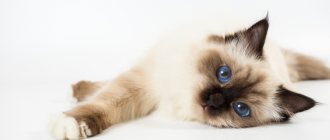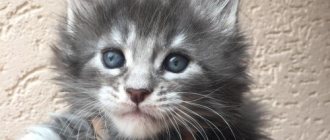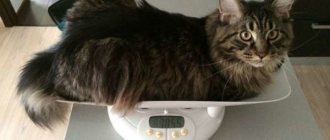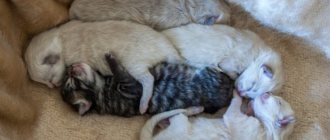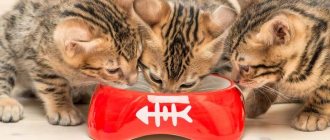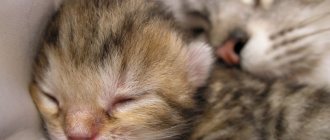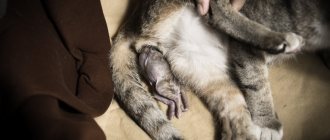Why do you need to know the age of cats?
The desire to find out what stage of life a pet is at is not just idle curiosity for most owners. Determining the approximate age helps to adjust the animal’s lifestyle, since each period has its own nuances. For example, the older the cat, the less physical activity its body can withstand. But young kittens cannot do without regular active games.
Since cats, like people, decline in health over the years, they become more susceptible to various diseases. Accordingly, care for older pets should be more thorough than for young animals. The choice of diet also depends on how old the pet is. For example, older cats whose teeth are already worn out find it difficult to chew rough food or dry food.
So, by calculating a cat’s age by human standards, you can not only improve the pet’s quality of life, but also make it a long-liver. As practice shows, with proper care and maintenance, cats can live up to 15, and sometimes even more, years.
This is interesting: What time do kittens start walking?
Simple Arithmetic
A very simple way to find out how old a cat lives by human standards is to multiply the animal's age by 7. This method gives the most inaccurate result of all those listed above, for example, a one-year-old cat is more independent than a child aged 7 years . The reason is that our pets are driven mainly by instincts, which help them adapt faster. Also, cats more often live to be 20 years old than humans are to live to be 140. This arithmetic method, in which the year of a cat’s life by human standards is equal to 7 years, does not make it possible to compare the stages of development of intelligence.
Converting a cat's age to human age using the proposed systems is not difficult. The main problem is that none of the existing methods will give an accurate result.
How to calculate a cat's age by human standards
There are several ways to determine the age of cats: look at the pet’s passport or look at the condition of the teeth. However, without medical knowledge, the number of years a four-legged friend has lived does not mean anything. Even if the vet informs you that your cat is 12 years old, how old is that in human years? The fact is that the life expectancy of representatives of the cat family is much shorter than that of humans.
Scientists have put forward several assumptions regarding this aspect. The first option is that cats’ hearts beat faster, which means the duration of a single biochemical reaction is much longer. This means that the body's tissues and cells wear out faster. The second judgment is the high speed of physiological regulation, provoking rapid “cementation” or osteogenesis of the connecting parts of bones, openings for nerve exits and other systems.
Such physiological processes mean that the animal loses the ability to regulate blood circulation, nerve centers, the functioning of the musculoskeletal system and life processes in general several times faster.
Scientists and veterinarians have differing views on the relative age of cats by human standards. Some researchers suggest that a cat’s life year is equal to 7 human years, others equate it to 15, others equate it to 18, and still others equate it to 24.
How to calculate how old a cat is by human standards?
If you follow logical thinking and pay attention to the behavior of pets, then the closest to reality can be considered the judgment that the first year of a cat’s life is equivalent to 15 years of a person. Since the main growth of the body occurs in the first 3 years, all metabolic processes occur faster than in subsequent years: 2 years is approximately 24 years, and then we add another 4 to each previous year
By the age of 17, metabolic processes slow down, so it is advisable to further add 3 years. For clarity, let's make a table of the ages of cats.
This is interesting! The oldest cat died at the age of 38, which is approximately 146 years old in human years.
In cats, life stages are conventionally distinguished:
1. Kitten: 0-6 months The period when a young cat grows rapidly, develops and barely reaches sexual maturity.
2. Young cat: 6 months - 2 years The cat reaches its full adult size, learning about life and survival.
3. Cat in its prime: 2 years - 6 years The cat is fully developed physically and intellectually, she is healthy and very active, her coat looks smooth and shiny.
4. Mature cat: 7-10 years A cat is called mature when, by human standards, it can be given from 40 to 50 years.
5. Older cat: 11-14 years old The cat is about 70 human years old.
6. Older Cat: 15 Years and Up Many cats reach this stage without showing any signs of aging! Although the age of these cats by human standards is more than 70 years.
What can negatively affect a cat’s “human” age?
Of course, the above figures may differ from reality. All cats are different, and their lives also depend on their owner. Plus, different breeds have different life expectancies, which means the conversion factor into human years is also different.
That is, the human age of an individual cat may depend on factors such as breed, living conditions, quality of nutrition, previous diseases, etc.
Some things, of course, will remain unchanged, for example, the period of growing up and maturation. For animals such as cats, it is important that this period passes as quickly as possible. In nature, a lot depends on this - the survival of an entire population. This means that the first two years of your cat's life will definitely be the fastest, most active and filled with various events. But the rest of her life largely depends on you.
How to find out more accurately
It is possible to calculate the age of a cat, more precisely by human standards, using tables. There are a couple of consolidated ones that specify the age ratio of a person and a cat, first for a period of up to 1 year, and then after the pet reaches puberty. For the convenience of considering and converting cat years into human years, this information is combined into one common table.
| Animal lifespan | Human years | Animal lifespan | Human years |
| 1 month | 5-7 months | 7 | 54 |
| 2 months | 10-11 months | 8 | 57 |
| 3 months | 2 | 9 | 60 |
| 4 months | 5-6 | 10 | 63 |
| 5 months | 9-10 | 11 | 66 |
| 6 months | 13-14 | 12 | 69 |
| 7 months | 15 | 13 | 72 |
| 8 months | 16 | 14 | 75 |
| 1 | 24 | 15 | 78 |
| 2 | 36 | 16 | 81 |
| 3 | 42 | 17 | 85 |
| 4 | 45 | 18 | 87 |
| 5 | 48 | 19 | 90 |
| 6 | 51 | 20 | 93 |
This is interesting: How old is a 10-year-old cat by human standards?
Simple mathematical calculation scheme
Want to know how old your pet is?
To clearly compare the ages of a cat and a person, you don’t have to do a lot of counting; you just need to add seven. So:
- the first year of a cat’s life is equivalent to seven human years;
- the second - by fourteen;
- Twenty-one human years correspond to three cat years, and twenty-eight correspond to four.
Reference!
Next, the calculation changes and the number 4 is simply added to each digit. Thus, a five-year-old individual will correspond to a 32-year-old person. Starting from 16, you should add 3 human years of life.
Of course, such a distribution is conditional, but in the science of cats (felinology) it is customary to consider it this way.
Stages of life
- First stage: childhood. Lasts approximately six months after birth. During this time, the kitten learns about the world around it and its dangers, and constantly receives new information. For now, he walks next to his mother, who teaches him everything and protects him from dangers. At the end of the first stage of a cat's life, we have an 8-12 year old child.
- Second stage: youth. Lasts from six months to two years. Feline puberty, period of growing up, puberty. By the age of one year, the cat is already biologically ready to give birth, but it is better to wait until two years - by this time she has acquired all the vital skills and abilities.
- Third stage: youth. Peak of development and activity. It lasts from three to five years. The cat is playful, intelligent, inquisitive and very active. Ready to reproduce healthy offspring. If we compare this with human life, then here we are no longer a teenager, but a young man who has graduated from university and found a good job.
- Fourth stage: maturity . From the seventh to the tenth year of life. The cat becomes cynical and indifferent in its views on the world; it worries it less. More time is spent sleeping, and the animal’s gaze itself becomes disdainful and proud. The cat is still healthy and has a lot of energy, but she no longer has much desire to waste it on stupid games.
- Fifth stage: retirement. It is only thanks to today's veterinary advances that cats have begun to discover this magnificent stage of their lives en masse. Now they enjoy life like people of about 60-70 years old. Such animals live exclusively for themselves and for their own pleasure. They sleep, eat and look at the birds in the windows for a long time, no longer trying to catch them, no longer getting nervous.
- Sixth stage: old age. Cats at 15-16 years old are already considered long-lived. If your pet or pet survives to this stage, you are lucky. During this period of life, they become affectionate, faithful, and require more attention, love, care and warmth.
Comparison of the age periods of a cat and a person
Infancy
The period of infancy in a kitten passes more quickly than in humans. It only lasts a few weeks. During this time, the kitten goes through a difficult period, discovers a new world, and learns to walk.
shutterstock
Kittens are born blind, deaf and completely helpless. A week later, the protective film on the ears disappears, and the eyes open 5-9 days after birth. In the second week, teeth begin to cut. If we translate this age into human terms, then in our children this period begins 5-9 months after birth.
Month-old kittens are already running and jumping, that is, this is about a year and a half of a cat by human standards. A three-month-old cat is comparable in intelligence to a two-year-old child.
Childhood
Cat children develop very quickly, so it is not easy to compare this period with human children. At 4 months of life, these animals are already actively playing and communicating with other pets, recognizing “friends” and “strangers,” and can take care of themselves without the help of their mother (lick their fur, wash their faces, sharpen their claws, feed on their own). They learn all this from their mother’s example, although instincts also play an important role.
During the first year of life, a cat goes through all the stages of growing up, which is comparable to 18 years of human life.
This is why you should pay maximum attention to training your pet before he develops habits and games that you do not want or cannot tolerate. You must teach him that he cannot go to the toilet wherever he wants, he cannot sharpen his claws on furniture, etc.
Teenage years
You cannot treat adult cats like children; you cannot help but react to aggression, “puddles” and other harmful pranks, thinking that with age this will all stop by itself. Remember that a 6-month-old cat is comparable in human years to an already developed human teenager.
Although the kitten looks small and cute, like a child, it begins to test the boundaries of what is permitted. If the owner wants to raise an obedient cat, it is necessary to firmly and promptly stop “rebellion”.
The next unpleasant surprise for cat owners at this unusual age of animals is puberty. At the age of 6.5 months, female cats begin to go into heat, and male cats, in turn, can react to them, since they are already quite ready for mating. However, it is undesirable to allow mating, because during this period the cat is not yet ready for childbirth or motherhood, but she can become pregnant.
shutterstock
Youth
During its youth, the cat is strong, agile and tireless. For purebred cats, this is the best period for various competitions and exhibitions. Up to 7 years of age, the animal is optimally suited to have healthy offspring.
Maturity
This period can begin at the age of 6-10 years. By human standards, this is approximately 40-55 years. The cat can still play sometimes, but more often he behaves calmly. People who are engaged in professional breeding of purebred cats remove animals that have reached this stage from mating.
Old age
An elderly cat is considered to be an animal aged 10-12 years, although there are individuals that live up to 20 years.
Therefore, such an honorable age does not necessarily symbolize the proximity of death. It all depends on the conditions of its detention and state of health. For example, street cats rarely live to be 10 years old, while indoor cats often cross the 16-year threshold.
Don't be afraid of a cat's old age; with proper care, they feel great. It is not uncommon to find long-lived cats that live up to 20 years or more. For example, the Texas cat Pushinka lived 38 years.
https://youtube.com/watch?v=sffK5XP0Bfw
Ratio table
Like people, animals go through several stages of growing up: childhood, puberty, maturity and old age. It is necessary to take into account the rate of change at a particular stage in order to find out how old a cat is by human standards. The table below details the pet's maturation:
| Life stage | Cat age | Human equivalent |
| Kitten (birth – 6 months) | 0-1 month | 0-1 year |
| 2 months | 2 years | |
| 3 months | 4 years | |
| 4 months | 6 years | |
| 5 months | 8 years | |
| 6 months | 10 years | |
| Adolescent/young (7 months – 2 years) | 7 months | 12 years |
| 12 months | 15 years | |
| 18 months | 21 g | |
| 2 g | 24 g | |
| Adult (3-6 years old) | 3 g | 28 years |
| 4 g | 32 g | |
| 5 years | 36 years | |
| 6 years | 40 years | |
| Mature (7-10 years old) | 7 years | 44 g |
| 8 years | 48 years old | |
| 9 years | 52 g | |
| 10 years | 56 years old | |
| Elderly (11-14 years old) | 11 years | 60 years |
| 12 years | 64 g | |
| 13 years | 68 years old | |
| 14 years | 72 g | |
| Very old (15 years and older) | 15 years | 76 years old |
| 16 years | 80 years old | |
| 17 years | 84 g | |
| 18 years | 88 years old | |
| 19 years | 92 g | |
| 20 years | 96 years old | |
| 21 g | 100 years | |
| 22 g | 104 g | |
| 23 g | 108 years old | |
| 24 g | 112 years | |
| 25 years | 116 years |
The calculation starts at a rate of 1 in 12, peaking at one year of age (1:15) and gradually falling to a ratio of approximately 1:4.6. It shows that the pet is a dynamic variable.
It is necessary to build on current figures in order to understand and determine how old the cat is by human standards. The table describes in detail the interspecific proportions.
Determining age by external signs
Animals are not always adopted by owners in infancy. If a person has an adult cat, an examination will help determine its age:
- Body. An animal that has survived several years on the street has dense muscles. Brownness is a sign of most homeless individuals. But the young cat has soft muscles. Years of fighting for territory form a densely built body with a minimum fat content, accumulating, if possible, in preparation for winter. In older individuals, sagging skin on the abdomen (under the arms) and protruding shoulder blades are observed.
- Teeth. A white, healthy jaw is a sign of an individual aged 1-2 years. Of course, kittens can also have dental problems. But it is possible to distinguish inflammation caused by poor nutrition from plaque that has formed over the years. The latter may not cause discomfort, but will stain the enamel dark.
- Wool. Helps to determine by touch the age of a cat by human standards. The table indicates that the pet lives more than 100 years, when translated into the owner's chronology. The older the individual, the tougher its pile. Older animals may also experience gray hair and localized baldness.
- Eyes. In young people - clear, without signs of tears or mucous discharge in the corners. Although their appearance is also facilitated by pathogens and weakened immunity. The texture of the iris is one of the ways to determine the age of a cat by human standards. In young individuals it is relatively uniform - with the exception of pigment spots or traces of injury. With age, the vessels of the organ appear. Lacrimal tracks are also formed, into which secretions caused by injuries, infections and inflammatory processes flow.
People communicate not only with pets, which they raise from infancy. Having realized that a 7-year-old cat by human standards is equal to 44 years old, they can begin to have great respect for their dacha “neighbor” who has survived another winter. Understanding the relationships will also help in communicating with your own pet.
Why know your pet's age in human equivalent?
Life expectancy depends on conditions. So, the tramp will be lucky to celebrate 9 years - the cat, by human standards from the table, will turn 52 years old. In human terms, he will not even cross retirement age. On the street, an individual risks not living to see its 5th anniversary due to: transport;
- clashes with relatives and other animals;
- poor quality nutrition;
- atmospheric phenomena.
The home offers the pet a comfortable environment. But the owner should also recalculate the cat’s age in human years. When an animal enters the elderly phase, it becomes more susceptible to:
- cancer;
- diabetes;
- cardiovascular diseases;
- problems with kidneys and other organs.
The root causes of illness are poor diet, infections, injuries or contact with pathogens, such as fungus in the bathroom. But age additionally increases the likelihood of developing diseases due to weakened immunity.
As in the case of a person celebrating his 60th birthday, an animal older than 8-10 years needs attention to its health.
If castration (sterilization) has not been performed, the individual should be checked regularly (at least once a year) for signs of genital cancer. Regular examinations are also necessary in the presence of chronic diseases.
If at 6-7 years old a pet with kidney failure had enough proper nutrition, then after the 10th anniversary it is better to periodically (1-2 times a year, in the absence of signs of inflammation) give urine for analysis. For problems with the heart and other organs, regular checks are also advisable.
You should refrain from preventive visits to the veterinarian if your pet is nervous. If an elderly individual does not show signs of illness (weakness, anxiety, refusal to eat, etc.), there is no need to expose her to unnecessary stress.
Like any animal, a cat goes through several stages of development. These stages must be taken into account when comparing a pet's age to a human's. An individual grows fastest during the period of up to 6 months. Then the speed slows down gradually, reaching a ratio of 1 cat year to 4.5-5 human years.
Knowing the proportion will help calculate the age of the animal at a specific point in time and adjust its care at different stages of development.
The table also makes you think about the pet’s quality of life. So, if we start from the “dog” variable, a 15-year-old cat corresponds to a 105-year-old person (82.5 years, if we take a multiplier of 5.5). Respectable age.
But a dynamic calculation shows that such an individual dies at 76 years of age. Not much compared to a person who has access to quality food and health care. By monitoring the health of the pet, owners can ensure its “centenary” anniversary.
How to find out how old a cat is?
It is possible to calculate the age of a cat at home, although these data are considered approximate. This can be determined based on the data of the international veterinary passport of cats. This allows you to timely monitor age-related changes in your pet, providing it with the necessary measures to maintain its health.
Tough
Teeth are a kind of factor indicating age. When determining it, a person relies on the condition of his teeth, because over the years their appearance changes, despite the replacement of milk teeth with molars. Despite the fact that in some animals they are strong until old age, and in others they are sick almost from childhood, age can be determined by such signs as:
- shade of teeth;
- stage of attrition;
- accumulation of tartar;
- number of dropped units.
Cats whose owners brush their teeth and who visit the dentist have well-groomed teeth, which sometimes creates the illusion of a younger age. If kittens have an incorrect bite, dental problems cannot be avoided, and this adds age to the existing years.
Cats have excellent dental health within a year. At this time they are white, without ingrained yellowness and tartar deposits. At 2 years of age, the incisors begin to wear off, which is still not noticeable from the outside. A two-year-old cat has yellow teeth only if the owner does not brush them. By the age of four, the central and middle incisors are noticeably worn down. At the age of 6, the canines and outer incisors wear out, and at the age of 10, teeth begin to fall out. At 15 years of age, some individuals lose their fangs.
By the eyes
Like people, cats lose visual acuity over time, which is explained by the condition of the lens, and is also noticeable in the iris. A veterinarian can determine the age. Young animals do not have increased lacrimation. As for the iris, the more irregularities and inclusions it has, the older the cat.
According to the condition of the musculoskeletal system
You can understand the age of a cat by the structure of the musculoskeletal system, which affects the manner of movement. For example, kittens have disproportionate paws and are long relative to their body. A six-month-old baby seems lanky, after the end of puberty his body becomes stately and his gait becomes graceful. Kittens' ears grow faster than their skulls, but by the end of their growth this becomes unnoticeable.
Young cats are different in appearance; they have developed muscle relief. Their movements are easy and relaxed, at this age they are capable of long distances, and sometimes even shock the imagination with acrobatic tricks. This goes away with age: older animals remain agile, but over time they develop weakness in the joints. In addition, their spine may lower, they may experience protruding shoulder blades, thinning muscle relief, and weight loss.
By other external signs
You can determine the pet's age based on the condition of the coat (irrelevant for hairless cats). Despite the fact that the method is not as reliable in comparison with determination by teeth and eyes, it is no less interesting. For example, kittens up to one year old have a softer and silkier coat. There are practically no tangles on it, the condition is good, indicating excellent health.
Gray hair appears in cats when they are 7 years old. Early gray hair indicates the presence of diseases, for the solution of which you need to consult a doctor. From the age of 8, a fur coat becomes less attractive, and therefore the owner has to more carefully monitor its health and beauty.
In addition, you can understand that a pet has reached sexual maturity by its behavior. For example, starting from the age of six months, cats begin to actively mark their territory with their own urine, which has a pungent odor. Compared to human standards, at this time they are like teenagers with their rebellious spirit.
There are conventionally developed tabular data that clearly shows a person how old his pet is. The disadvantage of the data shown in the table is its inaccuracy.
As for a more accurate calculation option, to calculate it you need to have an idea of each stage of animal development. This allows you to paint a mental portrait by human standards. In cats of different breeds, the life resource during which a kitten is born, develops and grows old passes at its own pace.
For example, representatives of the Snowshoe breed reach venerable old age at 10-11 years of age. Asian tabbies live up to 20 years, Tiffany and smoky cats live up to 18, and some record holders of the cat family reach the age of 30 years.
What is the average life expectancy of cats?
In the wild, animals live a maximum of 5–7 years.
At home, life expectancy is significantly longer and averages from 13 to 18 years. True, there are also centenarians who are happy to celebrate their 20th anniversary.
Stages of life
The life of a pet goes through several stages:
- childhood . Ends at six months of age;
- youth _ The period lasts from six months to two years. Puberty occurs and changes in behavior are noted. Already at the age of one and a half years, a cat can give birth;
- youth . The stage lasts from two to five years. The blossoming of strength is noted. The pet is active and full of energy;
- maturity _ Lasts until the age of ten. The pet continues to remain active, but reacts more calmly to everything that surrounds it;
- pension and old age . Occurs between 11 and 15 years of age. The animal already requires special care. He is calm, less active. There is a deterioration in the condition of the coat.
Methods for converting a cat's age to human age
There are three main ways to convert a cat's age to human age. As zoologists admit, none of them is completely accurate.
Method No. 1
One year is taken as the starting point - the period of puberty of the kitten. This age corresponds to 16 human years.
The second milestone is two years, when character and behavior are finally formed. It can be considered 24 years by our standards.
After three years, age is calculated on a calculator using the formula:
x = 24 + (cat's age – 2) * 4
Method No. 2
The second method has its own formula for each of the three segments of life:
| Cat age (z), years | Formula |
| 1-5 | x = z * 7 |
| 6-11 | x = (z – 5) * 4 + 35 |
| 12-20 | x = (z – 11) * 3 + 59 |
Method No. 3
This technique was developed by zoologists and veterinarians. The basis is a coefficient that takes into account not only the physiological development, but also the psychological and intellectual level of the animal at each stage of life.
On this basis, a table has been compiled that allows you to approximately find out the relationship between the age of a cat and human ideas.
Kittens up to one year:
| Animal age (months) | Similar human age (years) |
| 1 | 0,5 |
| 2 | 1 |
| 3 | 2 |
| 4 | 6 |
| 5 | 10 |
| 6 | 13 |
| 12 | 18 |
Adult cats and female cats:
| Animal age (years) | Similar human age (years) |
| 2 | 25 |
| 3 | 32 |
| 4 | 35 |
| 5 | 40 |
| 6 | 43 |
| 7 | 46 |
| 8 | 50 |
| 9 | 55 |
| 10 | 60 |
| 11 | 64 |
| 12 | 67 |
| 13 | 70 |
| 14 | 72 |
| 15 | 75 |
| 16 | 76 |
| 17 | 78 |
| 18 | 83 |
| 19 | 91 |
| 20 | 100 |
Although this definition is closest to the truth, it must be remembered that it is impossible to accurately compare human and cat ages due to their fundamental differences in development as biological species.
How to determine the age of a cat by external signs
It is extremely difficult to determine the age of an adult cat by its appearance. Often animals of very advanced age do not look decrepit and weak. If the age of the new pet is unknown, you can try to find it out using the following parameters:
- Teeth. The only reliable criterion for determining age is the appearance and change of teeth - useful only for kittens. At 2-3 weeks, babies develop incisors, at 3-4 - canines, at 3-6 - premolars. Then, at 3-4 months, the incisors change, and at 4-6 months, the remaining teeth. By 7 months, the change of teeth is completed. After 1-1.5 years, a yellowish coating appears on the surface of the teeth, which becomes more intense over the years. Age-related tooth loss is an individual factor: some 16-year-old cats can boast a fully “complete” toothy mouth, and in some, dental diseases accompanied by tooth loss occur as early as one year of age.
- Wool. Until old age, healthy cats have a smooth and shiny coat and a dense undercoat. Then the undercoat thins out and the coat becomes less smooth. In long-haired animals in old age, a decrease in the volume of the tail due to wool is clearly noticeable. After 8-10 years, individual gray hairs may appear (total graying, as in humans, does not occur in cats). In old people, the fur becomes dull, the mustache thins and shortens.
- To the eyes. Up to 1-2 years, cats will retain “kitten” curiosity and enthusiasm in their eyes, even during rest. Older individuals look at the world more calmly and lazily. After 10-12 years, the eyes begin to gradually “sink”, but their clarity remains until old age, if the pet is healthy.
- Conditions. The body of young cats feels soft and plastic, and after 5 years it becomes denser, as if “hardening” (which does not in any way affect their dexterity). After 8-10 years, the contours of the cheeks, chin and body become less rounded. In old age, the muscular system and fat layer undergo dystrophic changes, the animal loses weight and “shrinks out.”
- Musculoskeletal system. The condition of the musculoskeletal system in cats changes little over the years, so gait practically does not change with age, and the ability to jump high remains in old age. Joint stiffness with a noticeable decrease in physical activity is typical in old age
A veterinarian can more accurately determine the age of a cat by examining the fundus of the eye or by the condition of the internal organs during surgery.
How many years do domestic cats live?
A domestic cat lives on average 15-17 years, however, 18-20 year old cat grandparents are also not uncommon these days. The longest living cats are those that live in a house without free-roaming and are well cared for. The life of homeless cats, whose life is full of hardships and dangers, is short - about 5-6 years. The fate of pets who end up on the street from home and are not adapted to independent living is an unenviable fate - they most often die within the first 1-2 years.
The lifespan of each cat is individual and largely depends on genetic predisposition. It is believed that breed does not affect life span, but this is not true. Unfortunately, to improve breed qualities, most breeders resort to closely related crossing of animals (inbreeding), which not only perpetuates the “ideal” appearance, but also unfavorable mutations. As a result, diseases that were rare 20-30 years ago have become commonplace today. Among them are hypertrophic cardiomyopathy, chronic renal failure at a young age, allergies and autoimmune pathologies.
Is it possible to increase the lifespan of a cat?
Any owner dreams of having a furry family member to please him for as long as possible. And he has the power to do everything so that the cat lives for 15, or even 20 years. What will prolong the life of your beloved four-legged animal:
- Annual vaccination
. The kitten is vaccinated in the first 2-3 months of life and then the procedure is repeated every year. This will protect both your indoor and outdoor cats from the most terrible viruses with a high fatality rate.
- Routine examination by a veterinarian
. Non-pedigreed cats get sick less, so they can be shown to the veterinarian during vaccination once a year - just ask the doctor about this. Pedigree animals and animals with chronic diseases require more frequent visits to the veterinary clinic - the frequency will be determined by the veterinarian himself.
- Sterilization and castration
. If you do not plan to breed kittens, be sure to sterilize your pet - this will help avoid many problems, including diseases of the genitourinary system and mental disorders.
- Attention to any changes in your pet's behavior
. Has your cat started drinking a lot? Stopped sleeping in your favorite chair? Is he limping? Are there strange discharges? Even such little things require close attention from the owner. The first action in case of suspicion is to call the veterinarian, he will tell you whether you need to take the animal to the clinic or if you can watch it at home.
- Purity
- the key to health. Cats groom themselves, but this is not enough to maintain hygiene. For example, long-haired breeds cannot cope with caring for a luxurious fur coat, and it must be combed regularly to prevent parasites or skin diseases. It is necessary to thoroughly rinse the cat's food and water bowls, disinfect the trays, and wash the bedding.
- Nutrition
must be maintained at a high level. It is not so important what you feed your cat - the main thing is that the selected diet suits it. A young cat will benefit from both natural food and high-quality dry food. But kittens and elderly individuals require a special menu, which cannot be cheap. Therefore, before getting a cat, think about the fact that in old age, in 95% of cases, it will require greater expenses than in youth.
- Treat your cat like a family member
. Consider the nature of the pet and its needs. If she doesn't tolerate loneliness well, you shouldn't leave her in the apartment all day. And on the contrary - if the kitty loves isolation, respect her personal space. There are many such points, and if you do not pay attention to the psychological state of the animal, it will constantly be sick and will not live very long.
This is not a complete list of what a loving owner can do. The most important thing is to be attentive and patient, treating your pet as a younger member of the family. Then he will live very long and happily.
How to extend the life of a cat?
If there is a kitten in your house, then you will want it to stay there forever, because it is these animals that create comfort in the house. No matter how sad it may be, unfortunately, nothing lasts forever and neither does this fluffy little ball... But let’s not talk about sad things! Let's try to extend the life of our pet. But it is possible!
Reference!
The average lifespan of a cat is 15 years. Scientists say that in the last decade it has increased by another 4 years.
Many factors influence the quality and life expectancy of a pet.
- The most important thing is attention! A lot of attention is, of course, good. However, you shouldn’t overdo it either, because cats are lonely, proud creatures and sometimes they need to be alone. Don’t worry, when the fluffy little ball gets bored, he will definitely let you know.
- High-quality and balanced nutrition makes your pet’s life even more colorful. Well, of course! Cats are hunters, and for them, eating delicious food is a very important component of a happy life. Choose only good food for your pet and treat it occasionally with treats.
- Another important factor is the absence of stressful situations. The more cloudless and comfortable a cat’s life is, the longer he will live.
- Cats love warmth and, of course, feel better in comfortable temperatures. Have you noticed that when they are cold they curl up into a ball? And vice versa, at the optimal temperature, cats feel comfortable, lay down with their belly up and thereby show you their trust.
- Unforced activity is what indoor cats need. Play catch or hide and seek with the cat. Just be careful! Beware of the claws! After all, cats are also hunters!
Long-livers in the world of cats
You always want to believe that a pet will become a happy exception and turn into the smartest/obedient/beautiful/healthy/long-living cat in the world. And indeed, this sometimes happens - and not so rarely. But some cases are like a miracle.
Long-lived breeds
Before getting a purebred cat, it is advisable to find out what diseases it is predisposed to and how many years it lives on average. Breeds that can easily live 18-20 years include:
- Savannahs (one of the most expensive cats);
- Siamese cats;
- Manx;
- Persian cats;
- rexes (Cornish, Devon and others);
- Egyptian Mau;
- Burmese;
- Russians are blue.
Their life expectancy is due to good genetics and good health. However, this list can include the most common “breed” in the world – an ordinary yard cat. Outbred mustachios easily break records, living up to 20 years with good care and the absence of diseases.
Record holders
There are two cats in the world who are over 45 years old - but both of them are not registered in the Guinness Book of Records, since there is no official confirmation of their age. Here are the animals that have received world recognition as record holders for life expectancy:
- Bagheera from Russia – 34 years old;
- Rubble from the UK - 31 years old;
- Cream Puff from the USA - 38 years old;
- Nutmeg from the UK - 32 years old;
- Scooter from the USA - 31 years old.
This is not a complete list of cats that lived 30 years or more. There are numerous references to other long-lived pets who have surpassed the 25-year mark. So the long life of a fluffy is not such a rarity, and one can only rejoice at this.
Independently determining the age of a pet by human standards at home is a rather difficult, but doable task. For this, at least a superficial knowledge of animal anatomy will be useful - then the degree of maturity can be determined by the condition of the oral cavity, coat and musculoskeletal system. Behavioral and mental abilities will help clarify this meaning. For those who prefer exact sciences, formulas for calculating the number of years based on available data will be useful.
The article is for informational purposes only. Contact your veterinarian!
Age comparison principles
There is an opinion that in order to calculate the age of a cat by human standards, it is enough to multiply it by seven. In fact, this approach is only valid for animals between three and ten years of age.
They grow up and grow old at a completely different pace than humans.
It is necessary to take into account the principles of recalculation:
- There is no calculation formula for cats under three years of age.
- A three-year-old animal reaches approximately the same degree of development as a person at 25-30 years old.
- From three to five years, this figure increases by 7 every year.
- From five to twelve years – by 4.
- After twelve years, each year is counted as 3.
Existing calculation methods
Calculations can be made in different ways. It is worth considering the most common of them.
Method 1
The simplest method is considered to be a ratio of cat to human age of 1:7. It is enough to simply multiply the pet’s age by seven and thus you will be able to get its human analogue.
As a result, it turns out that at one year a kitten is a child going to first grade. By the age of three he should have graduated from college. By the age of seven, the animal has already reached adulthood.
True, this method of calculation is not entirely correct. After all, a cat develops differently than a human. For example, in the first year her development is more rapid than that of seven-year-old children. By this period, the pet has already become sexually mature.
Method 2
According to the second method, the first year of an animal’s life is equivalent to 15 human years. By the age of two, the pet is already 24 by human standards. In the future, every year you need to add 4. In this case, the calculations will be more accurate.
